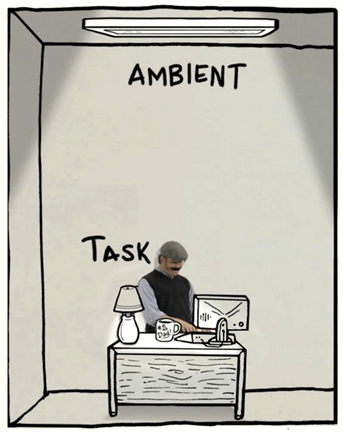For true visual comfort, you don't just need the right amount of illumination. Light needs to be well distributed to avoid discomfort.
Glare
Areas of high brightness right next to areas of low brightness cause glare, making people uncomfortable. For instance, having a bare lightbulb for your desk lamp may provide more than enough light. However, it would cause more light to shine directly into your eyes than reflects off the desktop, making it difficult to read or do other tasks. Having a shade on the lamp keeps the light from glaring into your eyes while brightly illuminating your desktop.
Unshielded light from bulbs or the sun can cause glare.
Light fixtures help distribute and diffuse light, and avoid glare.
Glare is especially important to control when using daylighting, since direct sunlight is so bright.
Light Levels and Glare Metrics
Glare is hard to measure because how light is perceived is subjective and depends on several factors (including the age of the person). However, the baseline metric used for assessing glare is luminance within a person's field of view measured at a specific vantage point (cd/m2). This is the amount of light reflecting off of a surface into a viewers eye (see Measuring Light Levels).
Some rules of thumb include:
- Avoid contrasts greater than 10:1 when doing tasks.
- Avoid an absolute illuminance value of 2,000 lux or greater. This is because most computer monitors are 200 lux, and you want to stay within 10x of that monitor brightness.
- A contrast of 20:1 means occupants will see silhouettes. This is often okay for corridors.
- A contrast of 50:1 causes discomfort, so it should always be avoided.
In daylighting analysis, glare is often assessed using fisheye views at a worker's head height. Also, several shorthand metrics have been developed to quantify glare, including the Unified Glare Rating (UGR) and the Daylight Glare Probability (DGP). The higher a DGP score, the more likely people will experience glare there.
Fisheye views of a workstation studying glare. With an HDR camera, a false-color overlay of luminance values on the image,
and a Radiance analysis with the same conditions. Image from Loisos + Ubbelohde.
Task vs. Ambient Lighting
Good light distribution also requires the right balance between ambient lighting and task lighting. Task lighting is the light actually used to perform a task, while ambient lighting is the general background illumination in the room.
A person doing detailed drawing may need 1,000 lux on their desktop surface, but the person next to them doing ordinary paperwork only needs 500 on their desktop, and the rest of the room may only need 150 lux for people to comfortably move around the room and enjoy the space. Ambient lighting requires so much less brightness than task lighting that addressing them separately is a very common strategy to save energy in electric lighting.
Some lighting design separates ambient and task lighting by having different sources for task lighting and ambient lighting. Other lighting design splits the output of lights so that the majority of each light is directed for task lighting, and a smaller percentage is diffusely spread for ambient lighting.
For visual comfort and energy efficiency, task and ambient lighting should be separated.
Links and References
- This paper from Jan Wienold at the 2009 IBPSA conference expands on the Daylight Glare Potential (DGP) methodology.
- This page explains how the Unified Glare Rating (UGR) is calculated.







